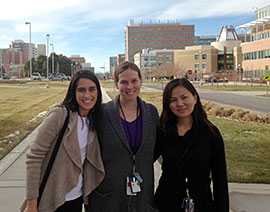Stevens-Johnson Syndrome Outbreak
Division of Bacterial Diseases (DBD) News Bulletin - Fall 2014
This website is archived for historical purposes and is no longer being maintained or updated.
November 7, 2014: Content on this page kept for historical reasons.
In This Issue
RDB Investigates First Stevens-Johnson Syndrome Outbreak in United States
When 8 cases of Stevens-Johnson Syndrome (SJS), a serious blistering disorder of the skin and mucous membranes, were identified at an academic children’s hospital outside of Denver, Colorado in November 2013, CDC’s Respiratory Diseases Branch (RDB) was asked to investigate what was to become the first documented U.S. outbreak of this very rare immune-mediated condition. It seemed as though Mycoplasma pneumoniae (M. pneumoniae) might be a factor in this outbreak.
M. pneumoniae is a very common cause of pneumonia in children and young adults that classically presents as “walking pneumonia” and is usually managed in an outpatient setting.
“While SJS has been associated with M. pneumoniae and other infections in children and young adults, it isn’t a contagious condition itself,” said Preeta Kutty, an RDB medical epidemiologist. “This syndrome is most often thought to be triggered by medications. The cluster identified in Colorado was certainly unusual and worthy of further study.”

Photo: RDB EIS Officers Alicia Demirjian and Louise Francois Watkins, with fellow EIS Officer, Xia “Michelle” Lin from CDC’s National Center for HIV/AIDS, Viral Hepatitis, STD, and TB Prevention, at the children’s hospital outside Denver, Colorado.
RDB’s Epidemic Intelligence Service (EIS) officers first set out to determine if the cases were in fact an outbreak through a manual review of patient charts to learn how many cases of SJS had been reported at this children’s hospital in recent years. Many questions needed to be answered. What could explain so many SJS cases occurring in one hospital in a short period of time? Was there a lot of unrecognized M. pneumoniae circulating in the community? If so, was there something different or unusual about the circulating strain that made it more likely for people to develop SJS? Thirty-seven SJS cases were identified at the hospital over the previous 5 years, prior to the 9 cases that occurred between August and November 2013. Based on the information gathered, the EIS officers concluded that the cases were indeed an outbreak, and that M. pneumoniae was the likely cause.
Louise Francois Watkins, a first-year RDB EIS officer involved in the investigation said, “Laboratory testing isn’t performed very often for typical M. pneumoniae infections but a number of factors allowed CDC to be fairly confident that there was a heavy burden of this disease in Colorado last fall.” Five of the 9 specimens from this outbreak tested positive for M. pneumoniae by polymerase chain reaction (PCR) undertaken at CDC’s Atlanta-based Pneumonia Response and Surveillance Laboratory.
Further laboratory testing showed that person-to-person transmission was high within affected households, supporting findings from prior M. pneumoniae outbreaks. Perhaps of greatest public health interest was subtyping specimens to determine if the strains involved in this outbreak were unique compared to the M. pneumoniae strains causing illness in non-SJS patients in Colorado.
“We still have more to learn about the clinical and epidemiological significance of M. pneumoniae subtypes. A single, shared strain among SJS patients may have suggested a particularly virulent strain was responsible for this outbreak,” said RDB microbiologist Maureen Diaz who processed the outbreak specimens. “Instead we found multiple subtypes that are similar to M. pneumoniae commonly identified in other investigations. We are definitely interested in exploring the genetics of these strains in more detail.”
Nearly all (93%) of the M. pneumoniae specimens, including all of those patients with SJS from this children’s hospital, were susceptible to macrolides, a class of antibiotics that is often used to treat this infection. This finding indicated that there is not a lot of resistance to the recommended treatment, azithromycin, in the M. pneumoniae circulating in Colorado.
With at least 7 more cases of SJS occurring at this hospital during the first 5 months of 2014, high levels of M. pneumoniae infection appear to be ongoing in Colorado. Infectious disease and primary care clinicians at this children’s hospital have been alerted to the likelihood of the outbreak, and encouraged to consider M. pneumoniae in their differential diagnosis and treatment plans for patients with community-acquired pneumonia. CDC’s laboratory analyses, including whole genome sequencing, will continue, allowing RDB to further unravel the mystery behind the first documented outbreak of SJS.
Epi-Aids/Outbreaks
Legionnaires’ disease outbreak—Birmingham, Alabama, May 2014. A team was deployed to assist the Alabama Department of Public Health in determining the extent of disease, and identifying, controlling, and mitigating any risks of continued exposure.
Legionnaires’ disease outbreak—Rabun County, Georgia, March 2014. A team was deployed to assist the Georgia Department of Public Health in determining the source of the outbreak.
Pertussis vaccine evaluation—Vermont, March-April 2014. A team of 30 CDC-based staff was deployed to work with 45 Vermont Department of Health staff to evaluate the effectiveness of pertussis vaccines in a setting of pertactin-deficient strains.
Pneumococcal disease outbreak—Ventura, California, June 2014. A team was deployed to assist the California Department of Public Health and Human Services’ Administration for Children and Families, Office of Refugee Resettlement (ACF/ORR) in determining the extent of disease and making vaccination recommendations.
Pneumococcal disease outbreak—Baytown, Texas, June 2014. A team was deployed to assist the Texas Department of State Health Services (TDSHS) and ACF/ORR in determining the extent of disease and making vaccination recommendations.
Pneumococcal disease outbreak—Ft. Sill, Oklahoma and Lackland, Texas, June 2014. A team was deployed to assist the Oklahoma State Department of Health, TDSHS, and ACF/ORR in determining the extent of disease and making vaccination recommendations.
- Page last reviewed: November 7, 2014 (archived document)
- Content source:


 ShareCompartir
ShareCompartir